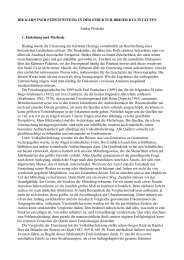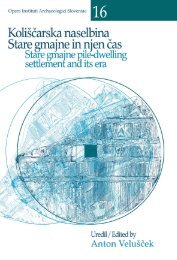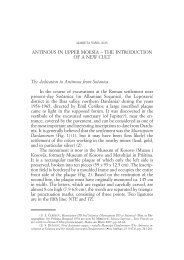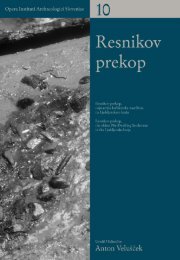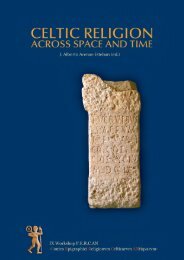Atti del Convegno Internazionale di Studi Trieste, 8-10 novembre 2007
Atti del Convegno Internazionale di Studi Trieste, 8-10 novembre 2007
Atti del Convegno Internazionale di Studi Trieste, 8-10 novembre 2007
You also want an ePaper? Increase the reach of your titles
YUMPU automatically turns print PDFs into web optimized ePapers that Google loves.
444<br />
Jana<br />
Horvat<br />
The beginning of Roman commerce along the<br />
main route Aquileia - Emona<br />
Abstract<br />
An important old route connecting the Italian peninsula with the central Danube region began at<br />
Aquileia and crossed the low-lying passes between the Julian Alps and the Dinaric Mountains. Selected<br />
archaeological sites in the Postojna and Ljubljana basins are <strong>di</strong>scussed with the aim of identifying the<br />
stages of the trade development during the 2 nd and 1 st centuries BC: Grad near Šmihel (the first half of<br />
the 2 nd century BC), numismatic evidence (the middle of the 2 nd century BC), the Razdrto Pass (the end of<br />
the 2 nd and the first third of the 1 st century BC), Nauportus and Emona (Augustan period).<br />
The foun<strong>di</strong>ng of the Roman colony of Aquileia in 181 BC and the occupation of Histria in<br />
178/177 BC had a profound effect on the north-eastern Adriatic area. 1<br />
By the middle of the 2 nd century BC, Roman ceramics (and other goods) were well represented<br />
in the coastal sites of north-western Istria. The best evidence for this was provided by the<br />
site of Sermin, probably a kind of a coastal emporium, where a large amount of later Greco-<br />
Italic amphoras originating from the Adriatic production centres had been deposited. 2 The<br />
settlements multiplied from the end of the 2 nd century BC onwards, offering an insight into<br />
the wide <strong>di</strong>ffusion of the Roman material, e. g. fine and common ceramics as well as amphoras<br />
Lamboglia 2, in the coastal zone. 3 On the other hand, the archaeological traces of the<br />
Romans in the mainland territory east of Aquileia in the 2 nd century BC are very sparse.<br />
Contacts and tra<strong>di</strong>ng with the peoples of the south-eastern Alpine area were of primary<br />
importance to Aquileia from the outset. 4 An important old route connecting the Italian<br />
peninsula with the central Danube region began at Aquileia and crossed the low-lying<br />
passes between the Julian Alps and the Dinaric Mountains (Fig. 1). Going eastwards<br />
from Aquileia, the first pass was Razdrto (598 m asl), situated at the western edge of<br />
the Postojna basin. The latter represented the crossroads of routes lea<strong>di</strong>ng from Aquileia,<br />
Tergeste, northern Istria and the Kvarner Bay. After that, the main route descended<br />
down to the Ljubljana basin, to the springs of the Ljubljanica river. There an old navigable<br />
route began that enabled transport far into the East along the Ljubljanica, Sava and<br />
Danube rivers. 5 Actually, two old long-<strong>di</strong>stance communications fork in the area of the<br />
Ljubljana basin, the so-called Amber Route lea<strong>di</strong>ng northwards (Aquileia - Celeia - Carnuntum<br />
- the Baltic Sea) and the route along the Sava river, also called the Argonaut’s<br />
Route (Caput Adriae - the Sava - the Danube - the Black Sea). 6<br />
The text below will <strong>di</strong>scuss selected archaeological sites along the main south-eastern<br />
Alpine route, in the Postojna and Ljubljana basins, with the aim of identifying the stages<br />
of the trade development during the 2 nd and 1 st centuries BC. The specific types of material<br />
traded will, for the most part, be neglected. 7<br />
The Postojna basin<br />
Grad near Šmihel<br />
An important prehistoric hillfort at Grad near Šmihel commanded the Postojna basin<br />
and the 7 km <strong>di</strong>stant Razdrto Pass. A large hoard was <strong>di</strong>scovered there, which predominantly<br />
contained Roman weapons for <strong>di</strong>stance fighting: heavy and light pila, incen<strong>di</strong>ary<br />
pila, javelins, catapult bolts, arrowheads and swords. Many of them were deformed -<br />
evidently previously used in battle. Based on the pila with flat hafts, the hoard could<br />
be dated to the end of the 3rd and the first half of the 2nd century BC. Historical circumstances,<br />
on the other hand, rather in<strong>di</strong>cate a burial from the first half of the 2nd century<br />
BC. The hoard should be tied to the otherwise unknown Roman military activity in the<br />
hinterland of Aquileia, which probably intended to establish control over the route and<br />
open the path for Roman trade towards the east. 8<br />
1 Šašel Kos 1997.<br />
2 Horvat 1997a, pp. 98-99, 118-120, 123, fig. 47; Kirigin 1994.<br />
3 Horvat 1995a; Horvat 1997a, pp. 120-130.<br />
4 Šašel Kos 1997.<br />
5 Šašel 1966; Šašel 1977; Tassaux 2004.<br />
6 Buora 1996; Šašel Kos 1997, pp. 34-38; Šašel Kos 2006.<br />
7 North-eastern Italian brooches: Demetz 1999; Božič 2008, forthcoming. Ceramics: Bezeczky 1987; Horvat<br />
1995a; Horvat 1997a, 118-130.<br />
8 Horvat 2002; Kmetič, Horvat, Vodopivec 2004; Horvat 1997b; Connoly 2000; Guštin, Gaspari 2005, pp.<br />
356-357.




